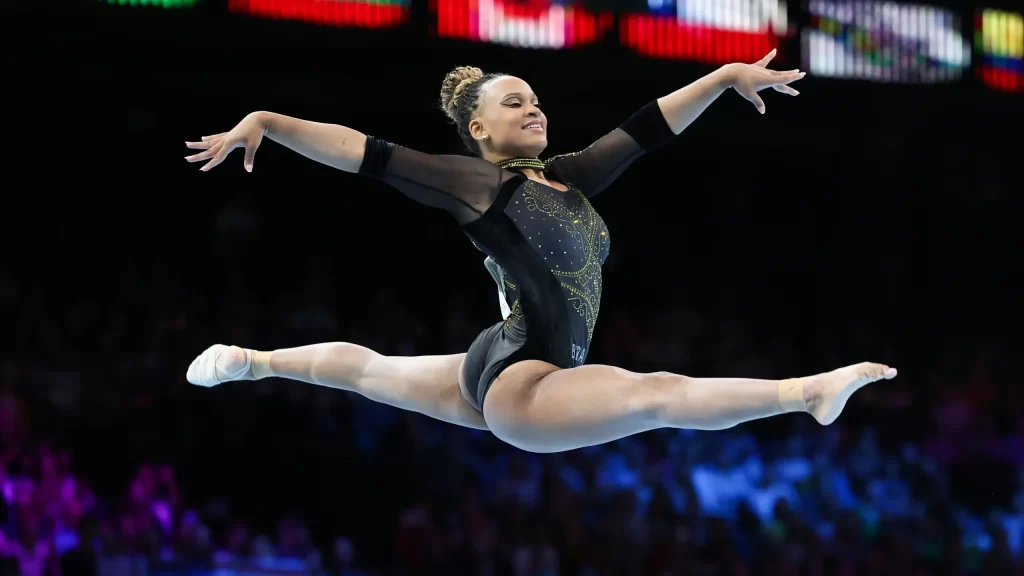Dazzling Excellence: Mastering Women’s Artistic Gymnastics
Dazzling Excellence: Grace in Motion
Women’s artistic gymnastics embodies a mesmerizing blend of athleticism, grace, and artistry. It’s a sport that captivates audiences worldwide with its breathtaking routines, executed with precision and elegance. In this comprehensive guide, we delve into the intricate world of women’s artistic gymnastics, exploring its history, disciplines, training methods, key athletes, and the evolving landscape of this captivating sport.
Dazzling Excellence: A Brief History of Women’s Artistic Gymnastics
- Origins: Tracing back to ancient Greece, where gymnastics was a fundamental part of physical education.
- Evolution: From early competitive displays in the 19th century to the establishment of international governing bodies such as the Fédération Internationale de Gymnastique (FIG).
- Milestones: Highlighting key moments in the sport’s history, including its inclusion in the Olympic Games in 1928.
Excellence: Disciplines and Events
- Vault: The explosive display of power as gymnasts catapult themselves over a vaulting table, showcasing strength and aerial prowess.
- Uneven Bars: A symphony of swinging and release moves, demanding exceptional upper body strength, coordination, and technique.
- Balance Beam: The epitome of grace under pressure, where gymnasts perform acrobatic feats on a narrow beam, demonstrating precision and balance.
- Floor Exercise: The canvas for artistic expression, where gymnasts combine athleticism with dance and music to create captivating routines. Read More

Dazzling Excellence: Training and Preparation
- Physical Conditioning: Emphasizing strength, flexibility, and endurance through rigorous training regimens tailored to each gymnast’s needs.
- Skill Development: Progressing from basic elements to intricate maneuvers through systematic skill acquisition and repetition.
- Mental Preparedness: Cultivating resilience, focus, and confidence to perform under the intense pressure of competition.
Dazzling Excellence: Key Elements of a Winning Routine
- Difficulty: The complexity of skills and transitions integrated into the routine, reflecting the athlete’s technical proficiency and innovation.
- Execution: The precision, fluidity, and control displayed in each movement, judged based on criteria such as form, amplitude, and landings.
- Artistry: The expression, musicality, and choreography that elevate a routine beyond athleticism to an artistic masterpiece.
Dazzling Excellence: Notable Athletes
- Nadia Comăneci: The Romanian sensation who achieved the first perfect 10 in Olympic history at the 1976 Montreal Games, revolutionizing the sport.
- Simone Biles: The unparalleled American gymnast whose unparalleled athleticism and fearless innovation have redefined what’s possible in women’s gymnastics.
- Olga Korbut: The Soviet gymnast whose charismatic performances captivated the world and inspired generations of athletes.
Dazzling Excellence: The Evolving Landscape
- Technological Advances: The impact of video analysis, biomechanics, and sports science on training methodologies and performance enhancement.
- Changing Trends: From the introduction of new skills and elements to shifts in judging criteria and scoring systems, shaping the sport’s evolution.
- Globalization: The growing diversity and competitiveness of gymnastics, with emerging talent from countries around the world challenging traditional powerhouses.
Dazzling Excellence: Challenges and Controversies
- Injury Prevention: Balancing the demands of high-level gymnastics with the need to prioritize athlete health and well-being, amidst concerns over the prevalence of injuries.
- Judging Integrity: Addressing controversies surrounding subjective judging decisions and ensuring transparency and fairness in competition.

Dazzling Excellence: The Impact of Women’s Artistic Gymnastics
- Inspiration: Empowering women and girls to pursue their dreams and defy stereotypes through the universal language of sport.
- Legacy: Celebrating the enduring legacy of trailblazing gymnasts whose achievements continue to inspire and shape the future of the sport.
Women’s artistic gymnastics is more than a sport; it’s a captivating spectacle that celebrates the extraordinary capabilities of the human body and spirit. From the dazzling displays of athleticism to the poignant moments of artistry and expression, it continues to enthrall audiences and inspire generations. As the sport evolves and new stars emerge, its essence remains unchanged: a testament to the indomitable power of passion, dedication, and sheer determination.
What age do female gymnasts typically start training?
Female gymnasts often begin training at a young age, typically between 5 to 8 years old. Starting at a young age allows gymnasts to develop the flexibility, strength, and coordination necessary for the sport’s demanding skills.
How long does it take to become a competitive female gymnast?
The timeline to become a competitive female gymnast varies depending on individual talent, dedication, and training environment. Generally, it takes several years of consistent training, often ranging from 8 to 12 years, to reach elite levels of competition.
Are there height and weight requirements for female gymnasts?
While there are no strict height and weight requirements for female gymnasts, the sport tends to favor athletes with smaller statures due to the advantage in performing certain skills and maneuvers. However, a diverse range of body types can excel in gymnastics, and success ultimately depends on skill, strength, and technique rather than specific physical attributes.
How do female gymnasts stay safe while performing high-risk maneuvers?
Female gymnasts undergo extensive training in proper technique and skill progression to mitigate the risk of injury during high-risk maneuvers. Additionally, coaches and spotters closely supervise training sessions, and gymnasts often use specialized equipment such as safety mats and harnesses when learning new skills.




